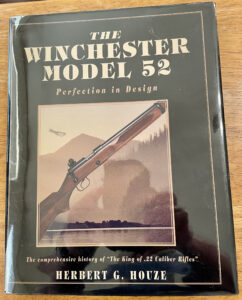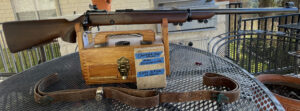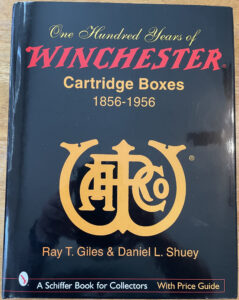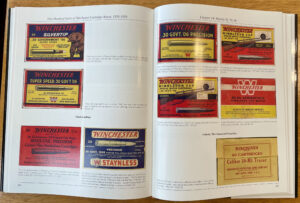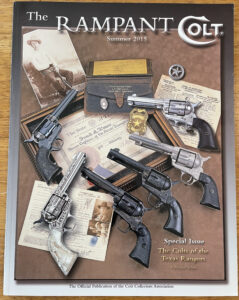One of the problems joys of being a hoplobibliophile (as opposed to being a normal person, or even a normal book collector): you buy a book on a particular gun for some reason. It might be well put together and illustrated, or it might just be cheap. Whatever. Next thing you know…you’re wanting the gun to go with the book.
The book:
The Winchester Model 52: Perfection in Design by Herbert G. Houze. According to the receipt I thoughtfully tucked inside the book, Half-Price had it for sale for $150 in July of 2016: I paid $75 for it during one of their coupon sales. And I had been looking (off and on) for a Model 52 since then…
I’ve only seen one other copy of this in the wild (there are some listed on ABE), and that was on our recent trip to the Tulsa gun show. The vendor was asking $495 for it. But that copy was signed. (Amazon page for the book, but not an affiliate link, because seriously, I can’t ask anybody to pay those prices. Unless you have a Model 52 and really really want the book.)
The gun:
Winchester Model 52 heavy barrel. Shown: sling, trigger, 5-round magazines and single shot adapter.
The Winchester Model 52 is probably the closest they ever came to making a .22 rimfire version of the Model 70. (I keep the Houze book shelved right next to my copy of The Rifleman’s Rifle (affiliate link). Because that’s just the kind of hairball I am.)
Field and Stream called it “one of the 50 best guns ever made” (though apparently in the Sporter variant, which I will discuss shortly). For a long time, this was the target rifle for people who were serious about match shooting. Even today, you could probably still do very well at a match with a Model 52.
Model 52 entry from Wikipedia. Model 52 from American Rifleman.
While the original Model 52 was designed as a target rifle, a friend of John Olin (Winchester’s president) had one of his modified into a lighter, handier sporter style rifle. Mr. Olin liked what his friend had done, and Winchester started producing Model 52 Sporters.
The first one of these I found in Tulsa was a Sporter, and I was planning on going back for it. However, the previous owner had put a scope on the Sporter, which is a fine thing to do. But in doing so, they removed the original rear sight. And I had a lot of trouble getting a good sight picture through the scope on that gun. I feel like I would have had to find a replacement rear sight for it, and move the scope to another gun. Also, I believe the dealer was asking $1,400 for it: I was going to see if I could talk them down. But then I found this one, which, while not a Sporter, is all original, and which I paid my target (heh) price for.
Estimates I’ve seen are that there were about ten times as many regular Model 52s produced as there were Sporters (and the Sporters get a higher price), but there were not a lot of Model 52s produced overall. The linked American Rifleman article says 125,233 produced from 1920 to 1980 (when it was discontinued) which works out to just under 2,100 rifles a year on average. (I don’t have a sense of how many of the regular Model 52s were produced in this heavy barrel configuration. That may be in the Houze book, but I haven’t found it yet.)
For comparison, based on the numbers at Pre64win.com, I come up with about 542,000 Model 70 rifles produced between 1936 and 1963, or roughly 20,000 a year on average.
When was it made? Reply sort of hazy, ask again later. The dealer who sold me the gun told me 1935. The Houze book has several tables of serial numbers, based on contemporary records kept by Winchester employees. According to a log kept by Winchester employee George Hertel (reproduced by Houze) this gun would have been made (or at least, the receiver would have been stamped with a serial number) on December 14th of that year. So call it a Christmas gun.
The Winchester Arms Collectors Association also agrees with 1935. On the other hand, this serial number reference from Winchester puts it in 1937. And you can order factory records from the Buffalo Bill Center of the West for either $75 or $40 (depending on the gun, and specifically how much information they have). I have not done this yet, but plan to soon.
(I’m trying to be careful in my wording. Houze points out that those logs give the date the serial number was stamped on the receiver, not necessarily the date the gun was shipped: he cites one case where the gun was shipped ten years after the serial number was stamped. This isn’t uncommon in the Smith and Wesson world, either: I’ve seen multiple cases on the forum where the shipping date on the gun is years after production was discontinued, or years before or after the serial number before that one was shipped, or or or…As Roy Jinks often says about Smith and Wesson (and this applies to other gun companies as well): they weren’t in business to make history, they were in business to make money.)
This is the gun that Sportsman’s Finest gave me the accessories for, including two spare five-round magazines, a vintage sling from 1918, and a replacement match trigger. I can’t say enough good things about them.
And now I’m thinking about adding a Sporter at some point. After all, I have more than one pre-64 Model 70…
(According to Wikipedia, there were replica Sporters produced in Japan in the 1990s and sold under both Winchester and Browning labels. I saw one of those this past weekend at the Waco gun show: the dealer was asking $1,600. For a replica. Original Sporters look to be going for around $4,000 on GunBroker. Sportman’s also has even more Model 52 parts, including a complete barreled action and what I think is a Sporter stock. After Christmas, I’m thinking about going back and talking with them about a deal to clean out what’s left. Maybe I can get someone to build a FrankenSporter for me out of parts?)
(The family rule is, you don’t buy stuff for yourself between Thanksgiving and Christmas, except essentials: food, gasoline, toilet paper, etc. This gun doesn’t count, as I bought it before Thanksgiving.)
Some other things picked up during the show:
C Stories by Jeff Cooper (affiliate link: you can also get it from the Gunsite Proshop for about the same price.). Nothing really special or spectacular about this, just another collection of Cooper writings that I didn’t have and got at a small discount from a dealer at the show. (This particular dealer didn’t have a business card or a website, and just sells books at the show and sometimes on eBay.) The whiteish mark at the top of the cover is a flaw in the cover protector, not in the dust jacket itself.
True story: I started flipping through another book at the same vendor’s table, got to the title page, and gasped audibly.
Vendor: “You don’t know much about book prices, do you?” That’s kind of the wrong thing to say to me.
Me: “No, I know book prices. I’ve just never seen a signed Elmer Keith book before.”
Safari on ABEBooks. They start at $375 and go up from there.
One Hundred Years of Winchester Cartridge Boxes 1856 – 1956. (Link goes to the publisher’s website page for the book, but is not an affiliate link. You can get it from Amazon (affiliate link) if you feel like it.)
Obviously, this is for serious collectors, but it is also the kind of weird thing that appeals to me. And it wasn’t that expensive for a specialized firearms book: $65 (signed by one of the authors).
I had made a note of the table location when we were going through the show, and as time was winding down, MtM and I decided to loop back and pick up some of the things we had made notes of before the show closed. When I got back to this table, he was packing up the books: I managed to catch him before he finished and snagged this one.
The book is exactly what it says on the tin: a copiously color illustrated and nicely put together collection featuring Winchester cartridge boxes between those two dates, organized by rifle make and model, and then by caliber within sections. For example, here’s two pages from the section on the Model 54, Model 70, and Model 88 with boxes for the .30-06 Winchester caliber. (I think my use of a single spread from the book, which is 312 pages total, can be called fair use.)
“The Rampant Colt”, Summer 2015. “The Rampant Colt” is the official publication of the Colt Collectors Association, which I am not a member of (yet). A dealer had a stack of back issues on his table, and I flipped through them looking for a specific one. Didn’t find it, but I did find this issue, which is devoted to “The Colts of the Texas Rangers”. And yes, it has many photos with short write-ups of Colts belonging to famous Texas Rangers. For example, there are four pages featuring Frank Hamer‘s Single Action Army revolvers. Purchased for $3, and worth every penny.
There was one other vendor at the show that I seriously considered making a purchase from: he had a two-volume set, also lavishly illustrated with color photos, dealing with the various commemorative rifles issued by Winchester. Winchester issued a lot of commemorative rifles, especially commemorative editions of the Model 94. Here’s one example.
Unfortunately, he was asking $115 for the first volume, and $100 for the second. While I had $215 in cash left on me, and while I am interested in the Winchester commemorative guns, I haven’t decided if I’m $215 interested in them. Then again, you never pay too much for a book: you just buy it too soon. If two volumes on Winchester commemoratives sound like your kind of thing, the author gave me a business card for comminvest94 (at) yahoo.com, who you can mail order both volumes from.
